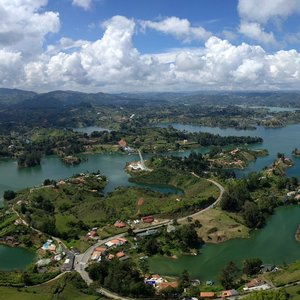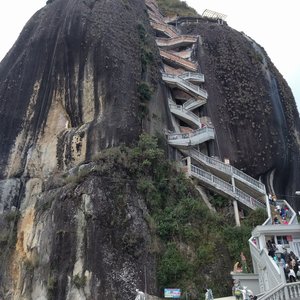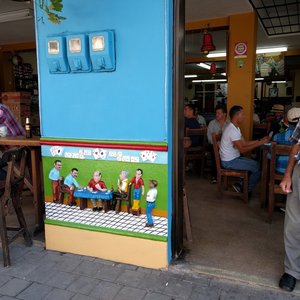Medellín and Salento
We continued our trip in Colombia through Medellín, the second-largest city in Colombia, and afterwards headed to a small town in the middle of Colombia’s coffee region.
Medellín
After spending a full day relaxing on the beach on Isla de Tierra Bomba, Cartagena, we boarded a late night plane for Medellín. The flight was under an hour, however with the 45 minute drive into the city (and the haggling over finding a decent taxi), we arrived quite late to our hostel at 2am.
The next day we slept in for a bit and then ventured out into the city. There were so many people out on the streets in the center that it ended up feeling a bit overwhelming. When it began to rain, we tucked into a busy cafeteria style restaurant for a coffee. Megan witnessed an older gentleman drinking some sort of malt beverage that looked interesting, so she ordered the same, however there was a miscommunication with the waiter–she received not only the drink, but the same large plate of fried chicken the man had ordered–he smiled and nodded at her approvingly.
We went to the Museo de Antioquia, an art museum that houses many works by Fernando Botero. This museum was highly impressive. One of the highlights is an installation done by the artist Erika Diettes: Relicarios. She travelled throughout Colombia to meet families who have lost a loved one to armed conflict and violence. She then took pieces of this persons life that the family has entrusted her with and enclosed them in a type of square “tomb”. When you walk into the room housing the installation, there are hundreds of these square tombs lined in aisles on the floor, so that you may walk through, look down, and view each one. It felt like a piece of each person was being preserved in a square of amber. There is no description attached to them, however, it appeared that many families chose to donate an article of clothing (many that appeared to be what the person was wearing when they were murdered) and a photo. For example, one “tomb” in particular that made an impact on us contained only a girl’s underwear and a rope that appeared to have bloodstains–heartbreaking.
In the afternoon, after taking some time to digest the museum, we decided to take two of the Metrocable lines in the city. This was highly interesting, as it’s one of the few places in the world that uses an aerial lift system as public transportation. The lines essentially connect some of the hard to reach favelas with the rest of the city, in theory giving the population of these underdeveloped regions access to jobs and other resources. The contradiction between the sleek modern design of the Metrocable, and the regions it’s meant to serve was hard not to notice. In the evening we ate at El Rancherito, a local chain that somebody from Medellín that we met in Cartagena recommended. The Bandeja Paisa, a famous dish from the region, tasted amazing.
The next day we took a day trip to Guatapé. It’s roughly 2 hours away and easy to reach by bus, we paid $4.50 to get there. The main attraction here is the view from La piedra del Peñol, essentially a giant rock that you pay to climb. While the view was beautiful, we actually found the city itself to be a highlight of the trip. The small city, is bright and colorful. Each home or business has tiled facades with many of them containing images of importance to the owner or business. For example, the bar had a bright facade of men drinking, while some homeowners had flowers or other decorative tiles.






















Salento
After Medellín we headed into the Andes Mountains to a small town called Salento. When we arrived on Sunday, the place was booming with Colombian families visiting for the weekend, however by Monday, it was a sleepy mountain town oozing laziness and relaxation. As this region is home to some of the best coffee farms in the world, we naturally took a coffee tour. We chose El Ocaso as the place to tour because it came at the recommendation of the family we had met in Cartagena–we were not disappointed. In the evening we strolled the square and took in a view of the city below.
The next day we got up early to do some hiking in the Cocora Valley. The highlight of this hike is the wax palms–it’s home to the majority of the remaining population in the world and it is the national tree of Colombia.



















